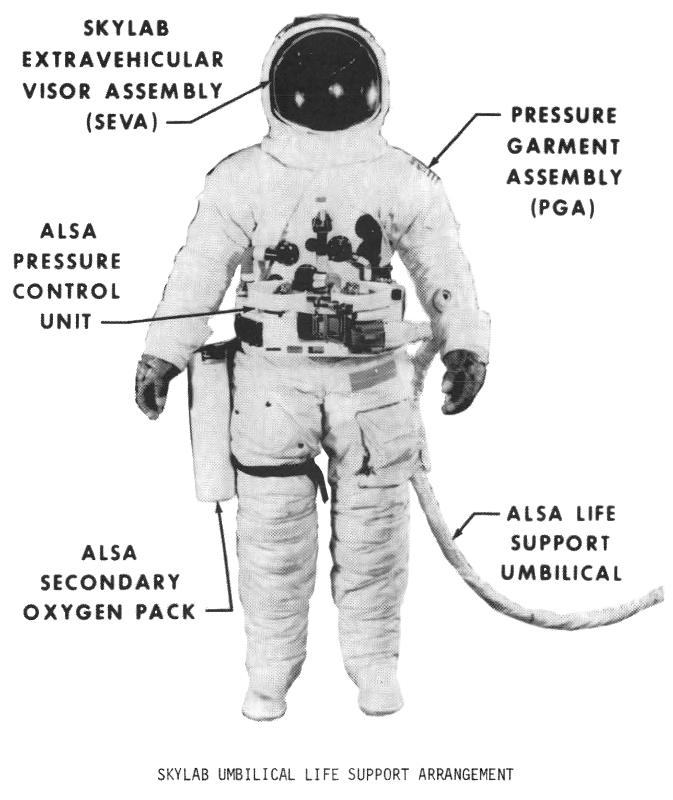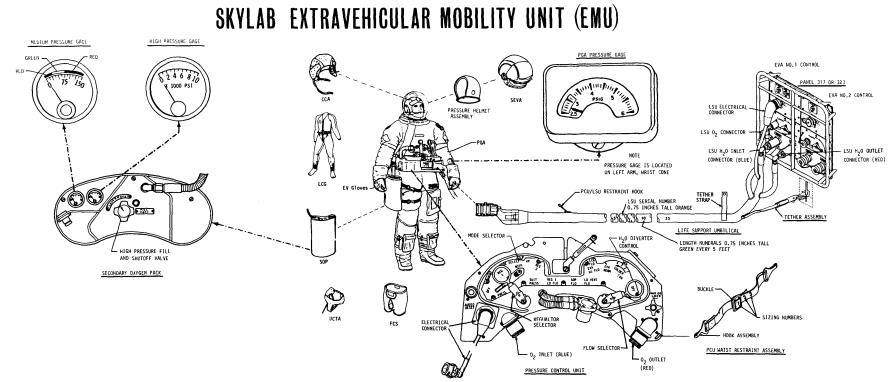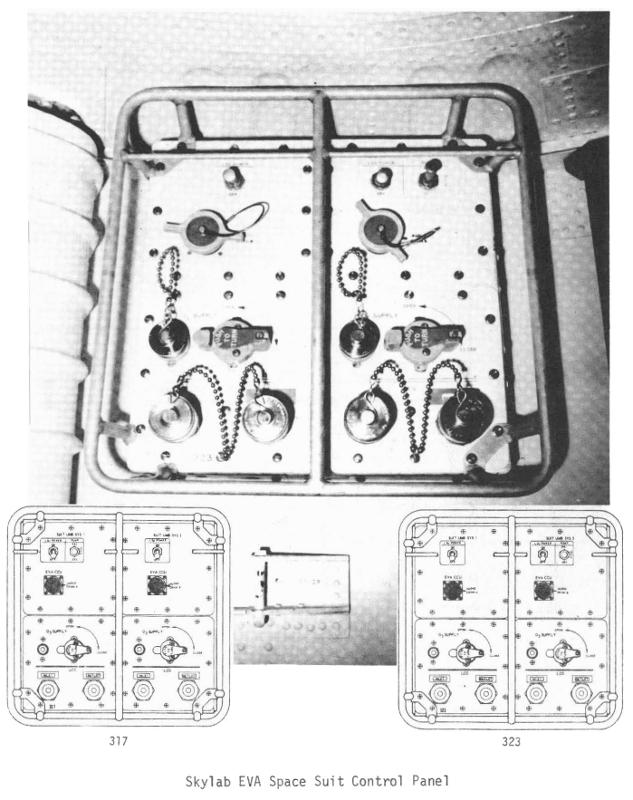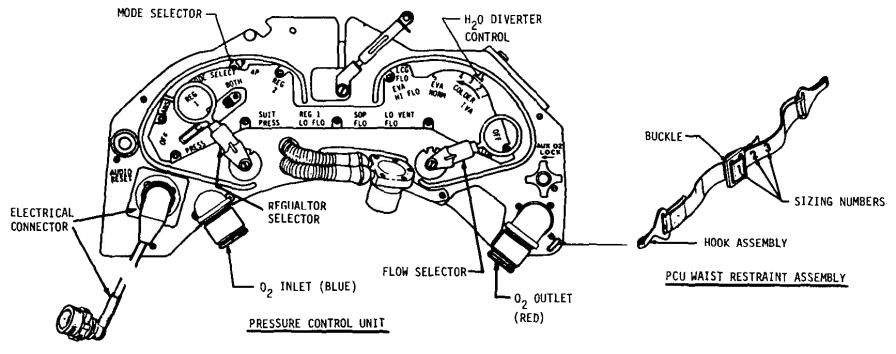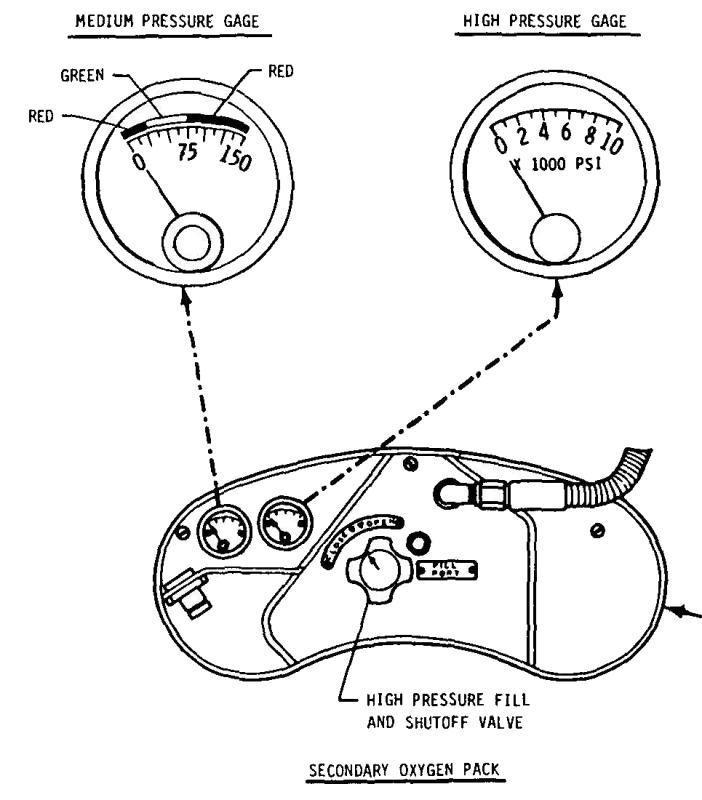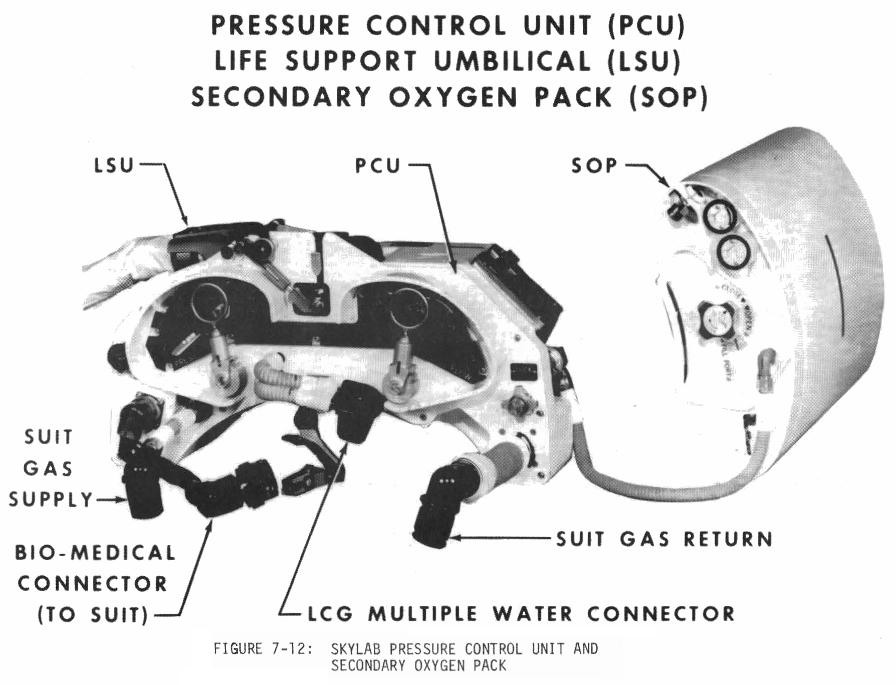Skylab A7LB Suit
For the Skylab program, NASA chose to modify the A7LB suit used on Apollo 15 through 17. In addition to modifications to the suit itself, the Skylab A7LB did not use the portable life support system (PLSS) "backpack" used in Project Apollo, but instead used a tethered system and a number of unique accessories.
Click image for a 1288x1532 pixel version of this image in a new window.
From p. 7-51 (p 202 in the PDF) of Application of EVA
Guidelines and Design Criteria. Volume 1: EVA Selection/Systems Design
Considerations
Extraction and cleanup by heroicrelics.
Click image for a 4424x2988 pixel version of this image in a new window.
From p. 7-36 (p 187 in the PDF) of Application of EVA
Guidelines and Design Criteria. Volume 1: EVA Selection/Systems Design
Considerations
Extraction and cleanup by heroicrelics.
US Spacesuits describes the differences between the standard Apollo A7LB suits and the Skylab A7LB suits:
NASA directed ILC to make minor changes from the Apollo 16 A7LB configuration. For Skylab, the front upper life support system bracket was revised to improve the umbilical tether attachment. The front lower life support system bracket was eliminated ... As the thermal requirements were less stringent, the visor assembly and pressure suit insulation layers were both revised. The Apollo 14-17 Lunar Extravehicular Visor Assembly (LEVA) was transformed into the Skylab Extravehicular Visor Assembly (SEVA) by relocating the opaque center visor under the visor shell and discarding the thermal outer cover on the visor assembly. The SEVA attachment approach was also revised to facility donning and removal. The thermal layers of the pressure suit were reduced from two layers of aluminized Kapton separated by beta marquisette and five layers of Mylar separated by non-woven Dacron as used in Apollo, to three layers of aluminized Kapton separated by beta marquisette for Skylab. To make it easier and faster to don and doff the pressure suit in zero gravity, the wrap-around zippers in the entry system were relocated lower on the torso. This sacrificed waist mobility, but the waist mobility that had been critical for the Apollo surface missions was not deemed critical for orbital EVA.
One of the experiments planned for Skylab was the astronaut maneuvering unit, a backpack unit similar to the AMU used on Gemini and the manned maneuvering unit (MMU) used on the Space Shuttle. This was apparently one of the reasons that the Apollo portable life support system (PLSS) was disqualified.
So, for the Skylab Astronaut Life Support Assembly (ALSA) NASA returned to a tether system similar to the one used in Project Gemini (although of course it had a new acronym, the life support umbilical or "LSU"). As described by the Development of an EVA Systems Cost Model. Volume 1: Design Guides Synopsis-EVA Equipment, there were two panels to which these LSUs attached; they were "located inside the airlock, accessible to the EVA crewman. Each panel was divided into two segments with each segment capable of supporting a suited crewman. Each segment contained a power receptacle with on/off switch for communications, an oxygen (O2) supply receptacle ... and two receptacles for the liquid cooling garment (inlet and outlet)." Apparently, each crewman used his own panel, rather than both crewmen using the same panel.
Click image for a 1907x897 pixel version of this image in a new window.
From p. 7-36 (p 187 in the PDF) of Application of EVA
Guidelines and Design Criteria. Volume 1: EVA Selection/Systems Design
Considerations
Extraction and cleanup by heroicrelics.
Click image for a 1398x1767 pixel version of this image in a new window.
From p. 1.3-22 (p 110 in the PDF) of Development of an EVA
Systems Cost Model. Volume 1: Design Guides Synopsis-EVA
Equipment
Extraction and cleanup by heroicrelics.
The LSU connected to a piece of hardware attached to the astronaut's suit at the waist which was unique to the Skylab program, the pressure control unit (PCU). The PCU accepted oxygen from both the umbilical and from the secondary oxygen package (SOP) (which, like the the Apollo PLSS oxygen purge system (OPS), contained an emergency supply of oxygen) and regulated the supply of oxygen to the suit's chest connectors.
Click image for a 1734x685 pixel version of this image in a new window.
From p. 7-36 (p 187 in the PDF) of Application of EVA
Guidelines and Design Criteria. Volume 1: EVA Selection/Systems Design
Considerations
Extraction and cleanup by heroicrelics.
Click image for a 2983x3872 pixel version of this image in a new window.
From p. 209 of the first edition of US
Spacesuits
Scan by heroicrelics.
The secondary oxygen package (SOP) contained a 30-minute supply of oxygen stored internally in two 6,000 psi cylindrical oxygen tanks. The SOP was strapped to the astronaut's right leg and connected to the PSU. Should the PCU detect a failure in the umbilical oxygen supply, it would automatically cut over to the SOP.
Click image for a 965x1100 pixel version of this image in a new window.
From p. 7-36 (p 187 in the PDF) of Application of EVA
Guidelines and Design Criteria. Volume 1: EVA Selection/Systems Design
Considerations
Extraction and cleanup by heroicrelics.
Click image for a 1788x1366 pixel version of this image in a new window.
From p. 7-50 (p 201 in the PDF) of Application of EVA
Guidelines and Design Criteria. Volume 1: EVA Selection/Systems Design
Considerations
Extraction and cleanup by heroicrelics.
In addition to the emergency spacewalks to free the jammed solar array and erect the various sunshades, there were regularly-scheduled EVAs to retrieve film canisters from the Apollo Telescope Mount. Of course, there are plenty of pictures from the spacewalks:
- SL3-115-1837 shows Owen Garriott with the SOP strapped to his leg and the PCU around his waist; the LSU appears to come up from behind him and enter the PCU at his left. Note that the PCU appears to have a thermal cover over it.
- MSFC-7200359 features Jack Lousma. We see the umbilical entering the PCU at the astronaut's left. The PCU lacks its thermal cover in this picture, offering a better view.
- MSFC-0302337 is a fun shot of an unidentified astronaut wa-a-ay out on the other end of the LSU.

